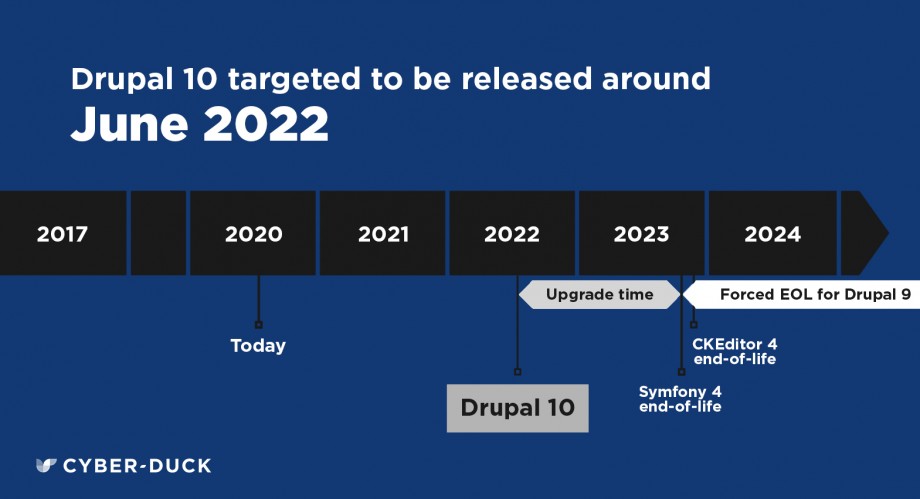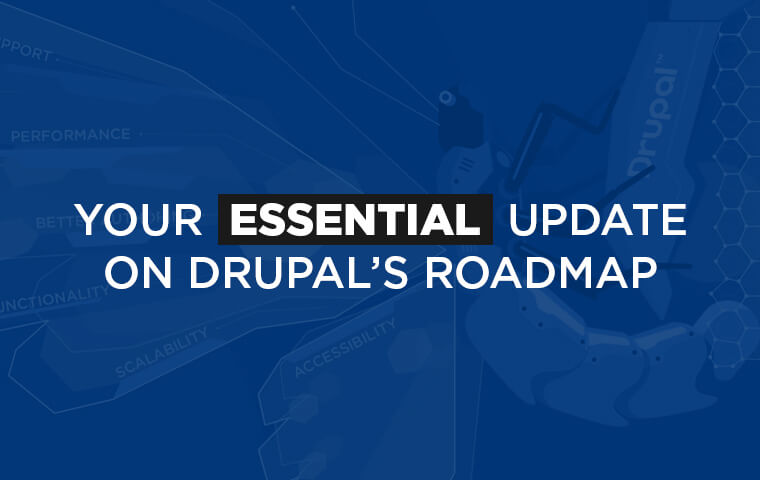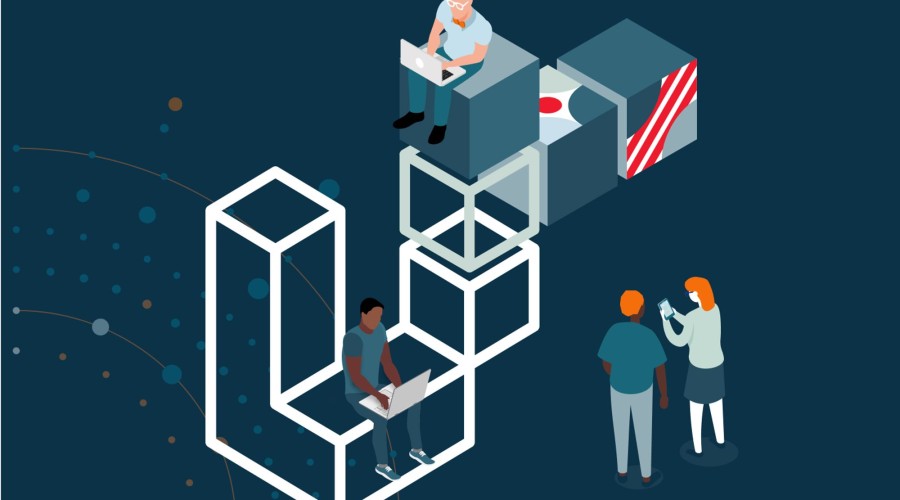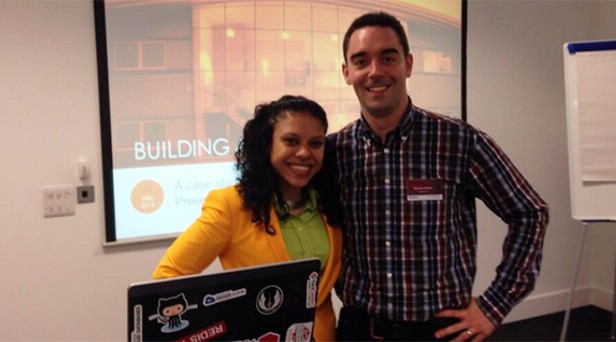7, 8, 9, 10 – no, we’re not line-dancing, we’re keeping track of Drupal’s release schedule.
Changes to Drupal 7’s end-of-life, the shift to 8, the release of 9 and the roadmap for 10: there’s a lot going on!
Get yourself up to speed in this rundown – and if your sites run Drupal, read the recap from our recent roundtable webinar, Drupal in 2021 and Beyond, and download our upgrade from Drupal 7 to Drupal 9 & 10 white paper.
What’s happening with Drupal 7 and 8 end-of-life?
Drupal 7 is reaching end-of-life in January 2025.
Drupal 8 end-of-life is November 2021.
Wait, Drupal 8 reaches end of life before Drupal 7?
Yes, that’s right.
Get in touch to request the full roundtable video for Drupal in 2021 and Beyond – it’s free!
Isn’t that weird?
Yes, a bit. It’s down to a key difference between how Drupal 7 and Drupal 8 were built. We’ll come on to that shortly.
Okay. What does that mean for me and my Drupal sites?
If you run Drupal, you’ll need to have migrated to Drupal 8 or 9 by these deadlines. Otherwise, you won’t get security patches and updates from Drupal – you’ll have to handle that yourself, which will be time consuming and expensive. (Please don’t do that ???? )
Right. So why does Drupal 8 reach end-of-life before Drupal 7?
Drupal 8 is a big step forward for the Drupal platform. It offers better UX, better caching, better functionality for content editors – all within a familiar interface.
That’s because under the bonnet, unlike Drupal 7, Drupal 8 onwards uses third-party components to power major aspects of its functionality.
But it also means Drupal’s release schedule has to align with these third parties’ releases. If a component that Drupal 8 uses reaches end-of-life, so does Drupal 8.
Drupal 8’s biggest dependency is Symfony 3. Drupal uses the Symfony framework, which is perfect for the creation of complex, secure, scalable and performant enterprise level applications such as Drupal. Symfony 3 reaches end-of-life in November 2021, so Drupal 8 must, too. Hey Presto! Drupal 9.
Gotcha. What about Drupal 7?
Drupal 7 doesn’t depend on so many third-party components and those it does depend on, like jQuery, have been frozen in time with a specific version included in Drupal core. This means Drupal can set its own end-of-life, but it also means those frozen dependencies get more and more out-of-date. Drupal 7 was originally end-of-life at the same time as Drupal 8, but because of the challenges of COVID-19, Drupal has postponed Drupal 7’s end-of-life until January 2025.
This is partly because Drupal recognises that the jump from Drupal 7 is a big one. It needs to be planned and conducted with care. (If you’re running Drupal 7, here’s a free white paper on that.)
Ok, thanks. So what’s the release schedule for Drupal 9 and 10?
Drupal 9 was released in June 2020. The first version was based on the last version of Drupal 8, which means the upgrade from 8 to 9 is relatively small. There are several releases of Drupal 9 planned, with 9.1 coming along in December 2020 and further updates every 6 months.
But those dependencies we mentioned continue to have a life cycle of their own, so Drupal is targeting June 2022 for the release of Drupal 10. That would give Drupal 9 users a full year to upgrade to Drupal 10 before Drupal 9 reaches end-of-life in November 2023. And remember, the upgrade from Drupal 9 to 10 will be really easy.

Drupal’s timeline to November 2023.
Why November 2023?
That’s when Symfony 4, Drupal 9’s biggest dependency, reaches end-of-life. Version 4 of the CKEditor WYSIWYG also reaches end-of-life around the same time.
Are Drupal’s release timeframes getting more compressed?
That’s a good question. Yes – and that’s likely to continue, because of the third-party dependencies we’ve talked about above.
However, the upgrades are far easier to implement than they’ve been in the past. The jump from 7 to 8 was technically complex (here’s that white paper to help you again) 8 to 9 is a breeze by comparison, and Drupal have already said they’ve found ways to make the jump from 9 to 10 even easier.
Think of it as baby steps rather than giant leaps – less stressful and more sustainable over the long term.
Think of the changes as a rebirth. You wouldn’t expect your smartphone to still be using the same operating system as a year ago and this is the same. Those dependencies built in to Drupal simply become replaced by something better and better is good. Version 5 of CKEditor has collaborative editing for example.
Should I stick with Drupal 7 for now?
In our view, no. There are huge benefits to moving to Drupal 8 or 9 now.
Firstly, Drupal 8 is a big step forward in functionality: advanced caching, customised content layouts with Layout Builder, a new Media Library, better UX and accessibility for end users and your team – that’s just a few of the many benefits. It’s also something you’re going to have to do eventually, so why not take advantage earlier.
Secondly, to your in-house team, they both look and work in a very similar way to Drupal 7. Yes, the back end is different, but when you edit and create content it feels the same. So you’ll be current from a technical standpoint, but it’s an easy move for your in-house team.
Finally, once you’re on Drupal 8, the upgrade path gets far easier. Drupal can now deliver customer value faster. They’re ramping up releases and, bug fixes and they’ve already brought 13 major features from experimental to stable. In Drupal creator Dries Buytaert’s words, “We’ve made it a lot easier to use and a lot easier to maintain.”
How is Drupal going to develop in the future?
Dries laid out his vision for Drupal’s development at DrupalCon Global this year. There are five strategic initiatives for Drupal, most planned for Drupal 10:
- Drupal 10 readiness
Making sure Drupal’s third-party components are upgraded, so Drupal stays secure and capitalises on their improved capabilities. - An easier out-of-the-box experience
Drupal 9 is far easier to use than its predecessors. Drupal now plans to build on that work and enable its new Media Library, Layout Builder and Administration Theme, Claro, by default. That’ll make it more attractive to new users – and help them get up and running faster. - A new front-end theme by default
Drupal’s front-end theme, Olivero, doesn’t ship with Drupal yet. From Drupal 9.1, released in December 2020, Olivero will be included by default. Olivero is clean, modern, accessible – it meets WCAG AA guidelines – and supports Drupal’s new features like navigation enhancements and Layout Builder. - Automated updates for security releases
Drupal’s most-requested feature is now road-mapped: Security updates will be automated! This will save organisations running Drupal both time and money. - An official JS menu component in React and Vue
Finally, the big news: Drupal is going to implement a JavaScript menu component in Vue and React, its first official JavaScript component. This is a big move, and one we see as really positive. It has four key benefits. It underlines Drupal’s headless capabilities and the groundwork needed to release it includes tools and processes that will form the foundation for future components. The JavaScript menu component will let non-coders update menus simply and easily. Finally, we’re hoping the menu component will be used on the Drupal admin UI, where WYSIWYG and drag-and-drop features have been high on our wishlist for some time.
Summary
So there you have it. Upgrade to Drupal 8 and 9 now and look forward to automated updates, new themes, out-of-the-box support for React and Vue, and hugely improved UX.
If you want more information on Drupal 9 or would like to plan your upgrade please get in touch.




